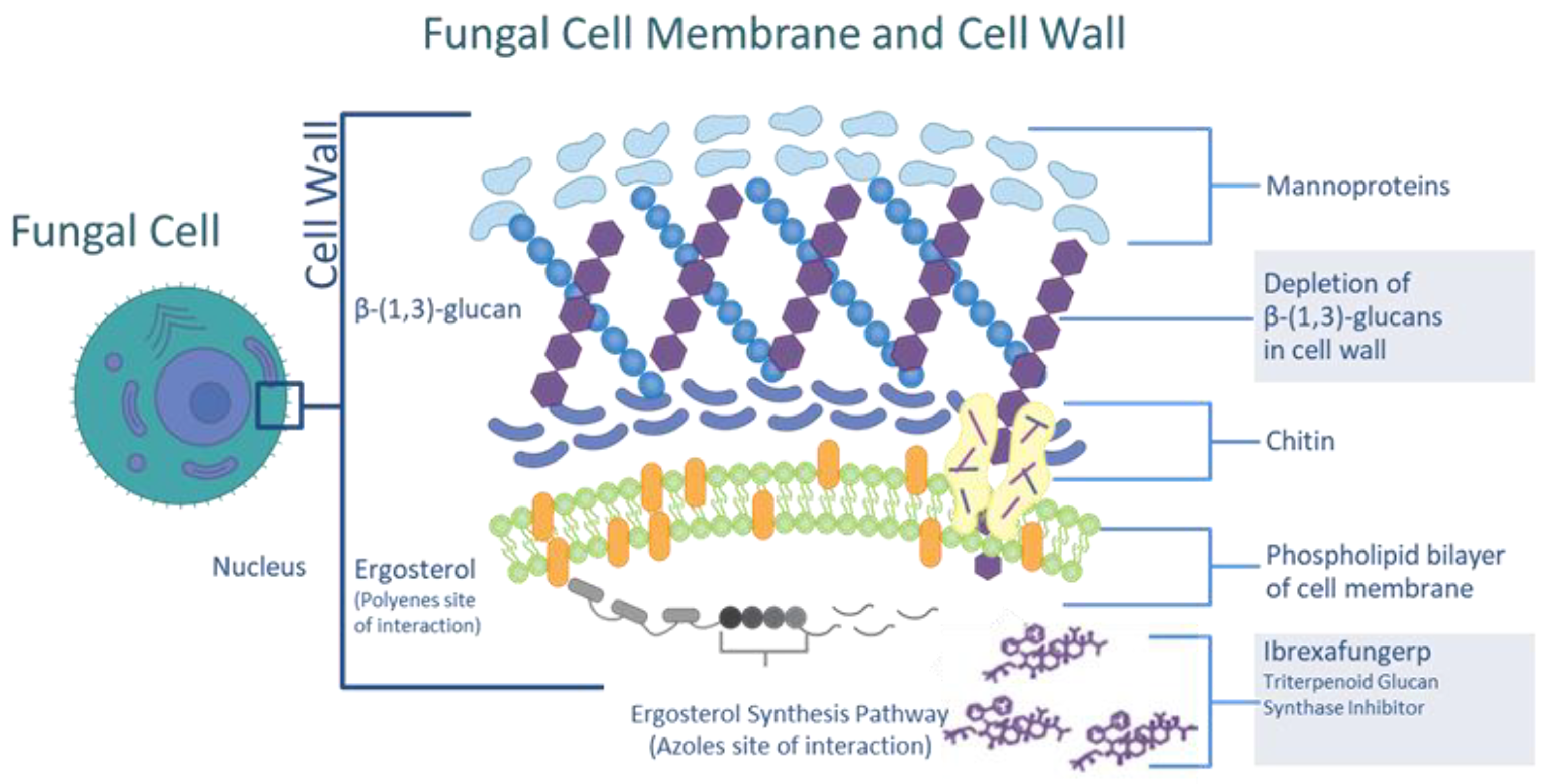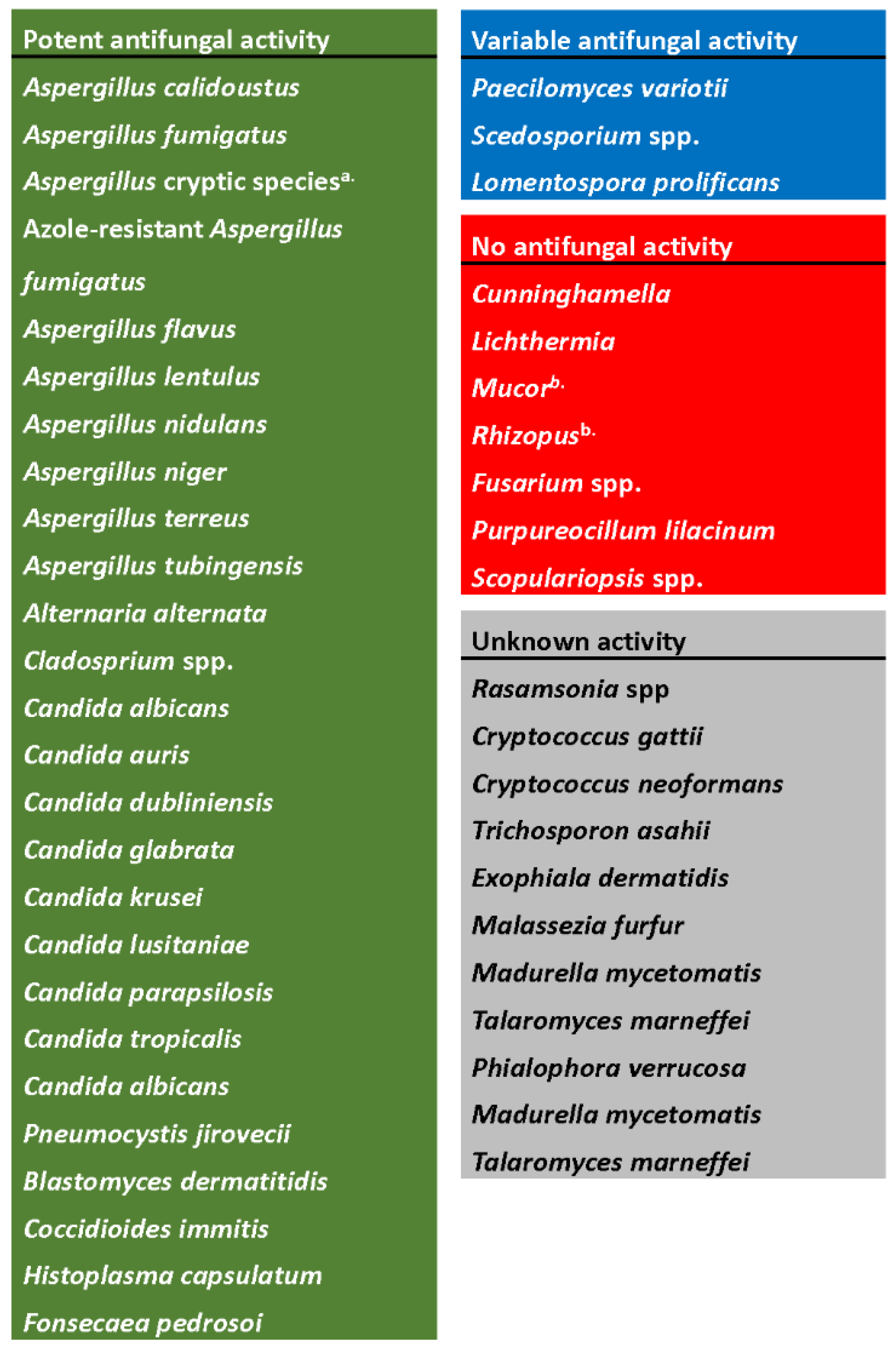Ibrexafungerp, an orally bioavailable glucan synthase inhibitor, is the first in a new class of triterpenoid antifungals and shares a similar target to the well-established echinocandins. Ibrexafungerp has a very favorable pharmacokinetic profile for the treatment of fungal infections with excellent tissue penetration in organs targeted by molds, such as the lungs, liver, and skin. Ibrexafungerp has demonstrated in vitro activity against Aspergillus spp. as well as efficacy alone and in combination with other antifungals in in animal models of invasive aspergillosis and mucormycosis. Furthermore, ibrexafungerp is approved for use in the USA for the treatment of women with vulvovaginal candidiasis and for the reduction in the incidence of recurrent vulvovaginal candidiasis.
- ibrexafungerp
- molds
- infection
1. Ibrexafungerp Mechanism of Action


2. Pharmacokinetics
| Tissue | Tissue:Plasma Ratio |
|---|---|
| Bone | 1.3 |
| Bone marrow (femur) | 36 |
| Brain (cerebrum) | 0.1 |
| Esophagus | 6 |
| Eye (uvea) | 117 |
| Heart (myocardium) | 10 |
| Kidney (cortex) | 25 |
| Liver | 56.5 |
| Lung | 26.5 |
| Lymph node | 38 |
| Oral mucosa | 5.5 |
| Salivary gland | 22.5 |
| Skin (non-pigmented) | 11.3 |
| Spleen | 75.6 |
| Urinary bladder | 7 |
3. In Vitro Activity against Aspergillus species

- a.
-
Includes A. fumigatiaffinis, A. thermomutatus, A. udagawae, A. hiratsukae, A. felis, A. citrinoterreus, A. carneus, A. aureoterreus, A. hortai, A. kevei, A. insuetus, A. ochraceus, and A. sclerotiorum.
- b.
-
No in vitro activity, although in vivo activity has been reported in animal models.
4. In Vivo Activity against Aspergillus spp. in Animal Models of Infection
This entry is adapted from the peer-reviewed paper 10.3390/jof8111121
References
- McCarthy, M.W. Pharmacokinetics and Pharmacodynamics of Ibrexafungerp. Drugs R D 2022, 22, 9–13.
- Wring, S.A.; Randolph, R.; Park, S.; Abruzzo, G.; Chen, Q.; Flattery, A.; Borroto-Esoda, K. Preclinical pharmacokinetics and pharmacodynamic target of SCY-078, a first-in-class orally active antifungal glucan synthesis inhibitor, in murine models of disseminated candidiasis. Antimicrob. Agents Chemother. 2017, 61, e02068-16.
- Davis, M.R.; Donnelley, M.A.; Thompson, G.R. Ibrexafungerp: A novel oral glucan synthase inhibitor. Med. Mycol. 2020, 58, 579–592.
- Wring, S.; Borroto-Esoda, K.; Solon, E.; Angulo, D. SCY-078, a novel fungicidal agent, demonstrates distribution to tissues associated with fungal infections during mass balance studies with intravenous and oral SCY-078 in albino and pigmented rats. Antimicrob. Agents Chemother. 2019, 63, e02119-18.
- Wring, S.; Murphy, G.; Atiee, G.; Corr, C.; Hyman, M.; Willett, M.; Angulo, D. Clinical pharmacokinetics and drug-drug interaction potential for coadministered SCY-078, an oral fungicidal glucan synthase inhibitor, and tacrolimus. Clin. Pharmacol. Drug Dev. 2019, 8, 60–69.
- SCYNEXIS, Inc. Ibrexafungerp (Approved Product Labeling). 2022. Available online: https://www.accessdata.fda.gov/drugsatfda_docs/label/2021/214900s000lbl.pdf (accessed on 21 September 2022).
- Murphy, G.; Darpo, B.; Marbury, T.; Hyman, M.; Angulo, D. Lack of an effect of SCY-078 a novel antifungal agent on QTc interval in healthy subjects. In Abstract 172, Proceedings of the ASM Microbe, New Orleans, LA, USA, 1–5 June 2017; SCYNEXIS, Inc.: Jersey City, NJ, USA.
- Hoenigl, M.; Sprute, R.; Egger, M.; Arastehfar, A.; Cornely, O.A.; Krause, R.; Jenks, J.D. The Antifungal Pipeline: Fosmanogepix, Ibrexafungerp, Olorofim, Opelconazole, and Rezafungin. Drugs 2021, 81, 1703–1729.
- Bowman, J.C.; Hicks, P.S.; Kurtz, M.B.; Rosen, H.; Schmatz, D.M.; Liberator, P.A.; Douglas, C.M. The antifungal echinocandin caspofungin acetate kills growing cells of Aspergillus fumigatus in vitro. Antimicrob. Agents Chemother. 2002, 46, 3001–3012.
- Odds, F.C.; Brown, A.J.; Gow, N.A. Antifungal agents: Mechanisms of action. Trends Microbiol. 2003, 11, 272–279.
- Ghannoum, M.; Long, L.; Larkin, E.L.; Isham, N.; Sherif, R.; Borroto-Esoda, K.; Angulo, D. Evaluation of the antifungal activity of the novel oral glucan synthase inhibitor SCY-078, singly and in combination, for the treatment of invasive aspergillosis. Antimicrob. Agents Chemother. 2018, 62, e00244-18.
- Pfaller, M.A.; Messer, S.A.; Motyl, M.R.; Jones, R.N.; Castanheira, M. In vitro activity of a new oral glucan synthase inhibitor (MK-3118) tested against Aspergillus spp. by CLSI and EUCAST broth microdilution methods. Antimicrob. Agents Chemother. 2013, 57, 1065–1068.
- Jiménez-Ortigosa, C.; Paderu, P.; Motyl, M.R.; Perlin, D.S. Enfumafungin derivative MK-3118 shows increased in vitro potency against clinical echinocandin-resistant Candida Species and Aspergillus species isolates. Antimicrob. Agents Chemother. 2014, 58, 1248–1251.
- Ghannoum, M.; Long, L.; Sherif, R.; Abidi, F.Z.; Borroto-Esoda, K.; Barat, S.; Wiederhold, N. Determination of antifungal activity of SCY-078, a novel glucan synthase inhibitor, against a broad panel of rare pathogenic fungi. In Proceedings of the ASM Microbe, Chicago, IL, USA, 18 June 2020.
- Petraitis, V.; Petraitiene, R.; Katragkou, A.; Maung BB, W.; Naing, E.; Kavaliauskas, P.; Walsh, T.J. Combination therapy with ibrexafungerp (formerly SCY-078), a first-in-class triterpenoid inhibitor of (1→3)-β-D-glucan synthesis, and isavuconazole for treatment of experimental invasive pulmonary aspergillosis. Antimicrob. Agents Chemother. 2020, 64, e02429-19.
- Jagadeesan, V.; Driscoll, E.; Hao, B. In Vitro Evaluation of Combination of Ibrexafungerp and Azoles against Aspergillus spp. Isolated from Lung Transplant Recipients. In Proceedings of the ASM Microbe 2019, San Francisco, CA, USA, 20–24 June 2019.
- Rivero-Menendez, O.; Soto-Debran, J.C.; Cuenca-Estrella, M.; Alastruey-Izquierdo, A. In Vitro Activity of ibrexafungerp against a collection of clinical isolates of Aspergillus, including cryptic species and Cyp51A mutants, using EUCAST and CLSI methodologies. J. Fungi 2021, 7, 232.
- CLSI. Method for Antifungal Disk Diffusion Susceptibility Testing of Nondermatophyte Filamentous Fungi, 1st ed.; CLSI Guideline M51; Clinical and Laboratory Standards Institute: Wayne, PA, USA, 2010.
- European Committee on Antimicrobial Susceptibility Testing (EUCAST). Eucast Definitive Document E.Def 9.4 Method for the Determination of Broth Dilution Minimum Inhibitory Concentrations of Antifungal Agents for Conidia Forming Moulds; European Committee on Antimicrobial Susceptibility Testing: Stockholm, Sweden, 2022.
- Rautemaa-Richardson, R.; Bazaz, R.; Cornely, O.A. Outcomes of Oral Ibrexafungerp by Pathogen from two open-label studies of patients with serious fungal infections (FURI and CARES). In Proceedings of the 10th Trends in Medical Mycology, Aberdeen, UK, 18 June 2021.
- Borroto-Esoda, K.; Barat, S.; Angulo, D.; Holden, K.; Warn, P. SCY-078 demonstrates significant antifungal activity in a murine model of invasive aspergillosis. Open Forum Infect. Dis. 2017, 4, S472.
